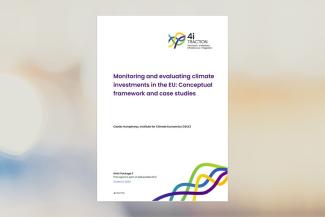
Humphreys, Ciarán (2024): Monitoring and evaluating climate investments in the EU: Conceptual framework and case studies. Institute for Climate Economics; Paris.
Monitoring and evaluating climate investments in the EU: Conceptual framework and case studies
This case study outlines design principles for climate investment monitoring and evaluation and assesses the current landscape of EU monitoring of climate finance.
Aligning the investment landscape with climate goals will be necessary to achieve net-zero and monitoring this alignment is an important part of climate governance. The EU does already have some mechanisms in place to monitor climate finance, yet this architecture stands to be improved to maximise the transformative impact that such a monitoring can achieve in terms of accelerating climate action.
The paper first outlines design principles for climate investment monitoring and evaluation. The types of investments to be monitored and the different roles of a financial monitor are outlined. The current landscape of EU monitoring of climate finance, including efforts by the European Commission, Eurostat and European Investment Bank, are mapped and assessed.
To inform future work on proposals for improving the EU governance architecture for climate investment monitoring, this paper describes and qualitatively analyses three case studies, including governmental and non-governmental, European, and non-European examples.
Selected Cases
The selected case studies for analysis are:
- French Green Budgeting: The French government began assessing the climate impact of its national budget in 2020 This “green budgeting exercise” examines the full range of budget lines across six environmental criteria, assessing whether their impact is positive, mixed, or negative to the environment.
- The European Climate Neutrality Observatory (ECNO): In 2023, ECNO was launched by a consortium of European NGOs and think tanks to monitor Europe’s progress towards climate neutrality. It has an economy-wide, cross-sectoral scope, with an analysis of 13 building blocks. Finance is one of these 13 building blocks, and investment tracking plays a part in other areas of the assessment as well.
- The Clean Investment Monitor: Launched in 2023 by Rhodium and MIT university, the Clean Investment Monitor tracks investments in clean technologies in the United States of America (USA). The Clean Investment Monitor tracks cleantech investment both before and after the entry into force of the Inflation Reduction Act, a policy which has accelerated US cleantech investment.
Directions for Future Reform
The analysis of the case studies give useful indications of directions for future reforms.
- To be of transformative impact, climate investment monitors should seek to cover a wide range of investments, across all three types. Since this may not be feasible, multiple complementary monitors may be required.
- Climate investment monitors should be well-resourced, with good access to granular data. Public institutions are therefore a good option to fulfil the role.
- Climate investment monitors should monitor both green and brown investments (along a gradated scale) and examine a range of climate impacts beyond climate mitigation.
- To have the most impact on climate finance policy, climate investment monitors should be explicitly connected to the policy process, integrate a range of stakeholders into its functioning, and/or incorporate a clear outreach or communications strategy.